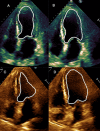A Case Report and 31-Case Study: Does Takotsubo Cardiomyopathy in Myasthenia Gravis Patients Have a High Mortality Rate?
- PMID: 36196306
- PMCID: PMC9525054
- DOI: 10.7759/cureus.28625
A Case Report and 31-Case Study: Does Takotsubo Cardiomyopathy in Myasthenia Gravis Patients Have a High Mortality Rate?
Abstract
Myasthenia gravis is an autoimmune disorder in which antibodies are formed against post-synaptic nicotinic acetylcholine receptors that lead to impeded muscle contraction and commonly affects the oculomotor muscles. Takotsubo cardiomyopathy (TTC) is a dilated cardiomyopathy that can mimic a myocardial infarction and causes reversible systolic dysfunction. This is a case of a 66-year-old Caucasian male with a known history of ocular myasthenia gravis that presented to the emergency room with worsening dyspnea secondary to a myasthenic crisis. One day, following admission, his shortness of breath failed to improve and was found to meet the diagnostic criteria for takotsubo cardiomyopathy. A brief review of 31 previous cases summarizes the current case reports, patterns, and mortality associated with the myasthenic crisis associated with TTC.
Keywords: broken-heart syndrome; myasthenia gravis; myasthenic crisis; stress-induced cardiomyopathy; takotsubo cardiomyopathy.
Copyright © 2022, Gayfield et al.
Conflict of interest statement
The authors have declared that no competing interests exist.
Figures


Similar articles
-
Takotsubo cardiomyopathy in the setting of a myasthenic crisis.Int J Neurosci. 2022 Jan;132(1):89-94. doi: 10.1080/00207454.2020.1797720. Epub 2020 Jul 23. Int J Neurosci. 2022. PMID: 32677485
-
A case of takotsubo cardiomyopathy leading to the diagnosis of myasthenia gravis.J Cardiol Cases. 2012 Aug 28;6(5):e141-e144. doi: 10.1016/j.jccase.2012.07.005. eCollection 2012 Nov. J Cardiol Cases. 2012. PMID: 30546723 Free PMC article.
-
Emotional stress as a trigger of myasthenic crisis and concomitant takotsubo cardiomyopathy: a case report.J Med Case Rep. 2010 Dec 3;4:393. doi: 10.1186/1752-1947-4-393. J Med Case Rep. 2010. PMID: 21129175 Free PMC article.
-
Takotsubo syndrome in patients with myasthenia gravis: a systematic review of previously reported cases.BMC Neurol. 2019 Nov 12;19(1):281. doi: 10.1186/s12883-019-1523-z. BMC Neurol. 2019. PMID: 31718587 Free PMC article.
-
A myasthenic crisis of broken hearts (reverse takotsubo): Case report and review of literature.J R Coll Physicians Edinb. 2022 Mar;52(1):27-29. doi: 10.1177/14782715221088913. J R Coll Physicians Edinb. 2022. PMID: 36146965 Review.
Cited by
-
Screening for immune-related biomarkers associated with myasthenia gravis and dilated cardiomyopathy based on bioinformatics analysis and machine learning.Heliyon. 2024 Mar 20;10(7):e28446. doi: 10.1016/j.heliyon.2024.e28446. eCollection 2024 Apr 15. Heliyon. 2024. PMID: 38571624 Free PMC article.
References
-
- Clinical features and outcomes of takotsubo (stress) cardiomyopathy. Templin C, Ghadri JR, Diekmann J, et al. N Engl J Med. 2015;373:929–938. - PubMed
-
- Takotsubo cardiomyopathy. Matta A, Delmas C, Campelo-Parada F, et al. Rev Cardiovasc Med. 2022;23:38. - PubMed
-
- Apical ballooning syndrome: an important differential diagnosis of acute myocardial infarction. Prasad A. Circulation. 2007;115:0. - PubMed
Publication types
LinkOut - more resources
Full Text Sources
